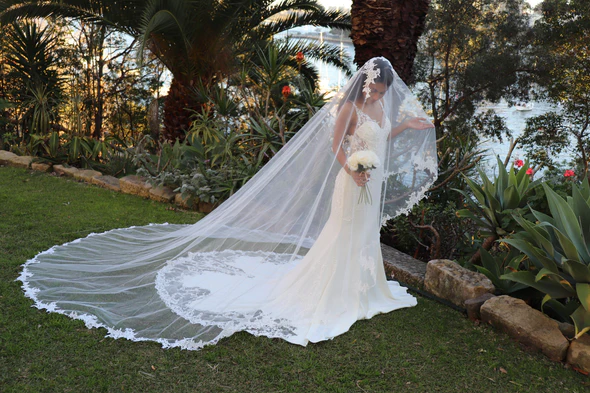What Are the Different Types of Wedding Veils? from Maurice Avrahm's blog
Wedding veils are a timeless and exquisite accessory that can transform a bride's look and add an extra touch of elegance to her ensemble. With various styles to choose from, selecting the perfect veil can be an exciting yet crucial decision for brides-to-be. From the classic cathedral veil to the whimsical birdcage veil, each option offers a unique charm that complements different wedding dresses and styles. In this article, we'll delve into the world of wedding veils, exploring the various types and the reasons behind their popularity.
Exploring the Diversity of Wedding Veils
Wedding veils come in an array of lengths, materials, and styles, making it possible for every bride to find one that resonates with her personal taste and complements her wedding gown. Here's a look at some of the most sought-after types of wedding veils:
Cathedral Veil: As the longest veil, the cathedral veil exudes grandeur and drama. It flows gracefully to the floor, often paired with ball gown or princess-style dresses for a regal effect.
Chapel Veil: Falling just below the waist, the chapel veil is a popular choice for brides desiring a classic and timeless look. It adds a touch of tradition to any wedding ensemble.
Birdcage Veil: A shorter, sheer veil that covers the face with a netting, the birdcage veil is a vintage-inspired option that pairs beautifully with strapless or sweetheart neckline dresses.
Mantilla Veil: Crafted from lace or tulle and adorned with an intricate border, the mantilla veil is favored by brides with Spanish or Portuguese heritage, adding an element of cultural significance.
French Veil: Characterized by its scalloped edge, the French veil exudes romance and elegance. It's an ideal choice for brides seeking a soft and ethereal look.
Edge-to-Edge Veil: This veil covers both the face and shoulders, made from tulle or lace. It complements strapless or sweetheart neckline dresses, creating a stunning visual impact.
Half-Veil: Falling shorter than a full-length veil, the half-veil covers the face and shoulders. Its versatile length makes it a suitable option for various dress styles.
Tiara Veil: Attached to a tiara, this veil is often paired with ball gown or princess-style dresses. It combines the elegance of a veil with the regal flair of a tiara.
Headpiece Veil: Attaching to a headpiece, this veil offers flexibility and can be paired with any dress style, allowing brides to express their unique style.
The Symbolism and Significance of Wedding Veils
Throughout history, wedding veils have held deep symbolism and meaning. Brides have worn veils for various reasons, including:
- Modesty and Purity: Veils have historically symbolized the bride's modesty and purity as she embarks on her journey as a married woman.
- Transition: The act of lifting the veil during the ceremony represents the bride's transition from single life to her new role as a wife.
- Protection: In some cultures, veils were believed to ward off evil spirits or protect the bride from any negative energy on her wedding day.
- Romance and Mystery: Veils add an air of romance and mystery to the bridal look, enhancing the anticipation and allure of the moment.
- Honoring Traditions: For some brides, wearing a veil honors cultural or family traditions that have been passed down through generations.
Choosing to Wear a Veil
While wedding veils hold rich cultural and traditional significance, wearing one is a personal choice. Some brides find joy and meaning in donning a veil, while others may opt for different accessories that resonate with their style. The decision to wear a veil should reflect the bride's personality and preferences, ensuring that her wedding day ensemble feels authentic and true to herself.
Crafting Your Own Wedding Veil
For brides who possess a creative flair and a willingness to embark on a DIY project, making a wedding veil can be a rewarding endeavor. Following tutorials and utilizing materials such as tulle, lace, and ribbon, brides can create a customized veil that perfectly complements their dress and personal style. Some tips for making your own wedding veil include:
- Selecting the Right Fabric: Choose a fabric that aligns with your vision, whether it's delicate tulle, intricate lace, or another material that resonates with you.
- Defining the Style: Decide on the veil style that enhances your dress and personal style. Whether it's a cascading cathedral veil or a chic birdcage veil, make sure it complements your look.
- Accurate Measurements: Accurate measurements are crucial to ensuring the veil fits you perfectly. Measure your head carefully to achieve the desired fit.
- Patience and Precision: Crafting a wedding veil requires patience and attention to detail. Take your time to create a veil that reflects your dedication and commitment to making your wedding day special.
- Seeking Assistance: If sewing is not your forte, don't hesitate to seek help from a skilled friend or family member. Their guidance can ensure a beautiful outcome.
In conclusion, wedding veils encompass a diverse range of styles and meanings, allowing brides to choose one that resonates with their personal taste and complements their wedding dress. From classic cathedral veils to whimsical birdcage veils, each option holds its own allure and significance. Whether you choose to wear a veil to honor tradition, add a touch of elegance, or embrace cultural heritage, the choice is a deeply personal one that contributes to the beauty and individuality of your wedding day.


The Wall